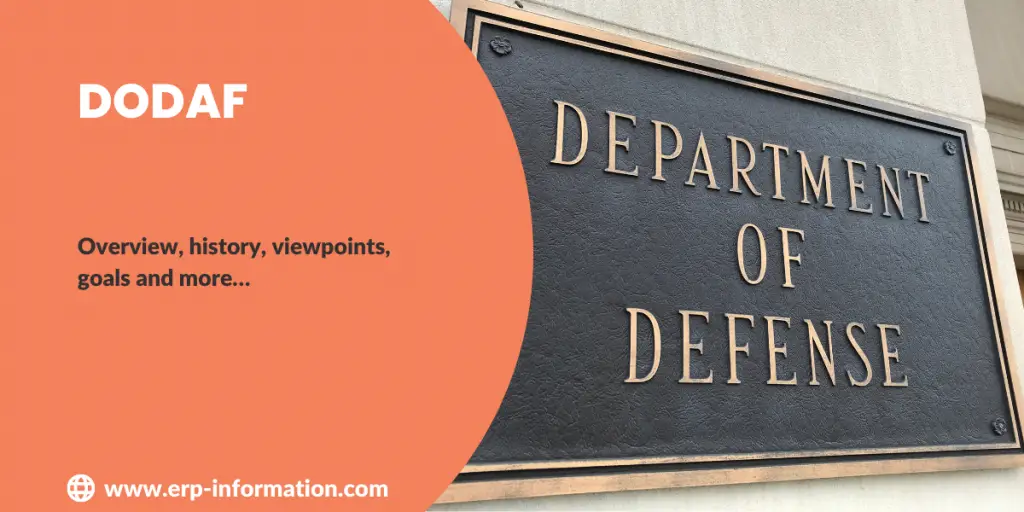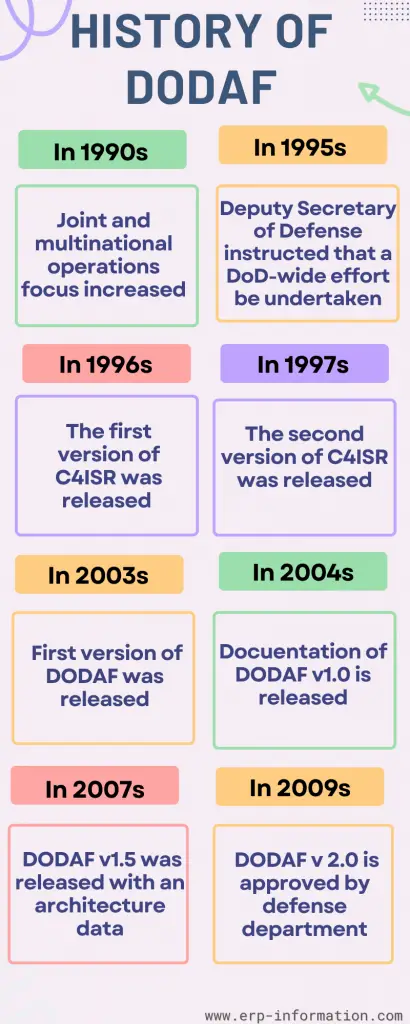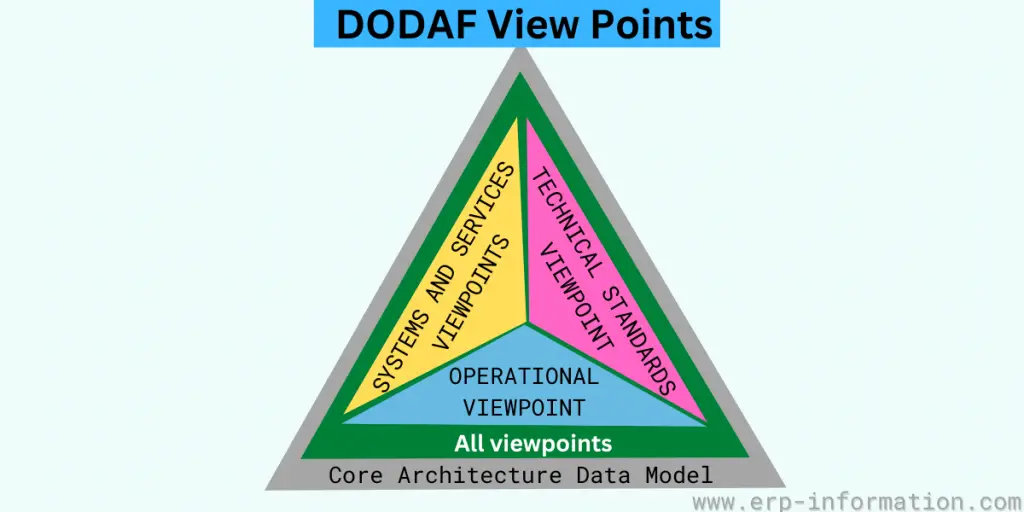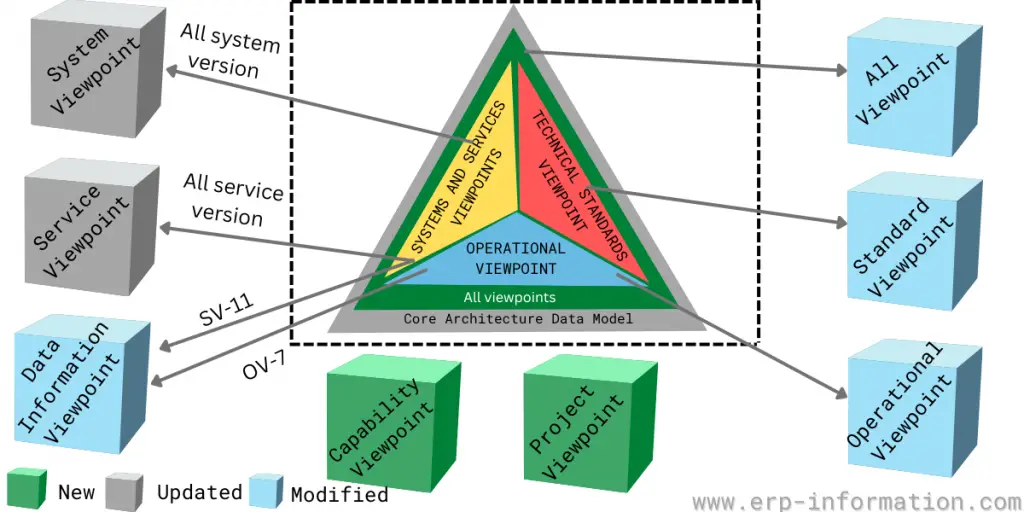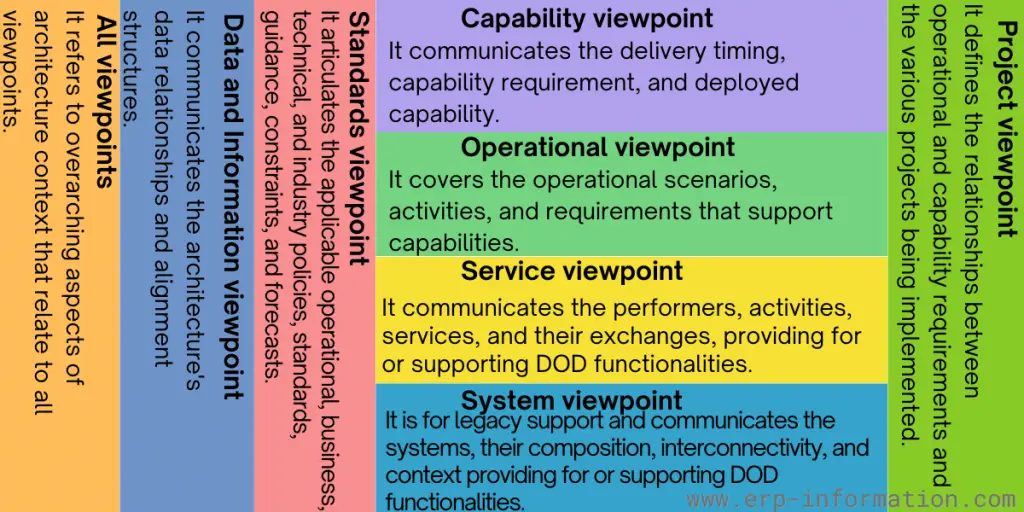The Department of Defense Architecture Framework (DODAF) is an essential tool for creating and visualizing comprehensive defense architectures.
By providing a unified language and standardized approach, it facilitates effective communication and collaboration among stakeholders, ensuring that defense systems are interoperable and aligned with strategic goals.
This blog post will discuss its viewpoints, history, core concepts, examples, diagrams, and the latest developments within DODAF, providing a detailed overview of its crucial role in shaping the architectural landscape of the Department of Defense.
Latest version: 2.02-DOD CIO
Release date: August 2010
DODAF Overview
The DOD Architecture Framework is a comprehensive framework for the Department of Defense (DoD). It provides a standardized approach to describing and visualizing architectures across all defense domains.
It defines a common language for stakeholders to communicate about architecture and establishes principles and practices for creating coherent and effective architectures.
The Department of Defense Architecture Framework is made up of two views:
- The operational view
- The technical view
The Operational View provides a high-level description of the system, while the Technical View describes the system in more detail.
In addition, DOD Architecture Framework diagrams are used to visualize architectures utilizing this framework.
DODAF defines concepts and models used in DOD’s six main processes.
- Joint Capabilities Integration and Development (JCIDS)
- Planning, Programming, Budgeting, and Execution (PPBE)
- Defense Acquisition System (DAS)
- Systems Engineering (SE)
- Operational Planning (OPLAN)
- Capability Portfolio Management (CPM)
Importance
The importance of the DoDAF framework lies in its ability to facilitate the transition from traditional, document-based, and code-centric systems development processes to a Model-Based Engineering (MBE) approach that is requirements-driven and architecture-centric.
By providing a standardized method for developing and documenting enterprise architectures, DoDAF ensures that all major U.S. Department of Defense (DoD) weapons and information technology system acquisitions are interoperable and aligned with strategic objectives.
DoDAF’s comprehensive set of views enables system architects, systems engineers, and software developers to create coherent and effective architectures, ensuring consistency and clarity across complex defense projects.
Its applicability extends beyond military systems, making it a valuable tool for various sectors, including private, public, and voluntary organizations globally.
As the preferred framework for defense and aerospace applications, DoDAF plays a crucial role in organizing and sharing large, complex system architectures for distributed Systems-of-Systems, such as Network Centric Operational Warfare architectures.
This capability is vital for managing the intricate interactions and dependencies inherent in modern defense systems, thereby enhancing overall mission effectiveness and operational efficiency.
History
In June 1996s, the first version was released under the name C4ISR architecture framework v1.0.
Before that, in the 1990s, the joint and multinational operations focus increased, and in the 1995s Deputy Secretary of Defense instructed that a DoD-wide effort be undertaken.
That is for defining and developing a suitable means and process for ensuring that C4ISR capabilities are interoperable.
In the 1997s, the second version of C4ISR was released. That is C4ISR architecture framework v2.0.
In August 2003 first version of the DOD Architecture Framework was released.
In February 2004, documentation of DOD architecture framework v1.0 was released with Definitions and Guidelines, Product Descriptions” and “Deskbook.”
In April 2007, DOD Architecture Framework v1.5 was released with an architectural data description.
In MAY 2009, the Defense Department approved the DOD Architecture Framework v 2.0.
Now the latest version of the DOD Architecture Framework is v2.02.
DODAF Viewpoints
In its starting version, that is, version 1.5, viewpoints are
- The operational viewpoint covers the operational scenarios, activities, and requirements supporting capabilities.
- Technical standards viewpoint
- Systems and services viewpoints
- All viewpoints – It refers to overarching aspects of architecture context that relate to all viewpoints.
In its latest version, version 2.02, the following viewpoints are added.
Capability viewpoint
It communicates the delivery timing, capability requirement, and deployed capability.
Data and information viewpoint
It communicates the architecture’s data relationships and alignment structures.
Project viewpoint
It defines the relationships between operational and capability requirements and the various projects being implemented.
Services viewpoint
It communicates the Performers, Activities, Services, and their Exchanges, providing for or supporting DOD functionalities.
Systems viewpoint
It is for Legacy support and communicates the systems, composition, interconnectivity, and context providing or supporting DOD functionalities.
Standards viewpoint
It articulates the applicable operational, business, technical, and industry policies, standards, guidance, constraints, and forecasts.
DODAF Diagrams
Presentation of viewpoint in graphic format
Goals of Version 2.02
- Initiate guidance for creating architecture content as a function of purpose or “fit for purpose.”
- Increase the advantages and usefulness of architectures through an attentive data model, the Department of Defense Architecture Framework Meta Model (DM2), so that it can be analyzed, evaluated, and eventually integrated more precisely.
FAQs
What is the standard viewpoint of DODAF?
The DoD Architectural Framework Standards Viewpoint is the set of rules that tell us how different parts of the Architectural Description should work together.
What is the difference between DODAF and TOGAF?
TOGAF provides a set of words to use when making and using the material. DODAF offers a shared language for architectural information.
What is the certification of DODAF?
DoDAF Certification is a way to organize how an enterprise architecture works. TONEX DoDAF 2.0 certification training helps people learn how to move from DoDAF 1.5 to DoDAF 2.02.
Conclusion
The Department of Defense Architecture Framework is a comprehensive guide for creating and managing architectures across the DOD.
The framework defines key terms, describes an architecture development process, and provides a set of models and views that can be used to describe any system or enterprise.
Using the DOD architecture framework can help organizations improve communication, collaboration, and innovation across all levels of the organization.
We have covered the basics of what the DOD Architecture Framework is and how it can be used to benefit your organization.
Reference
